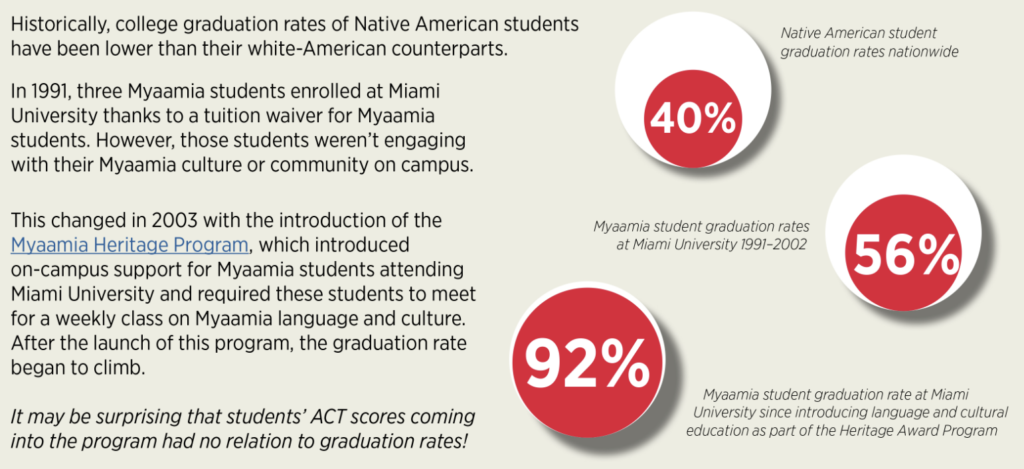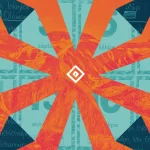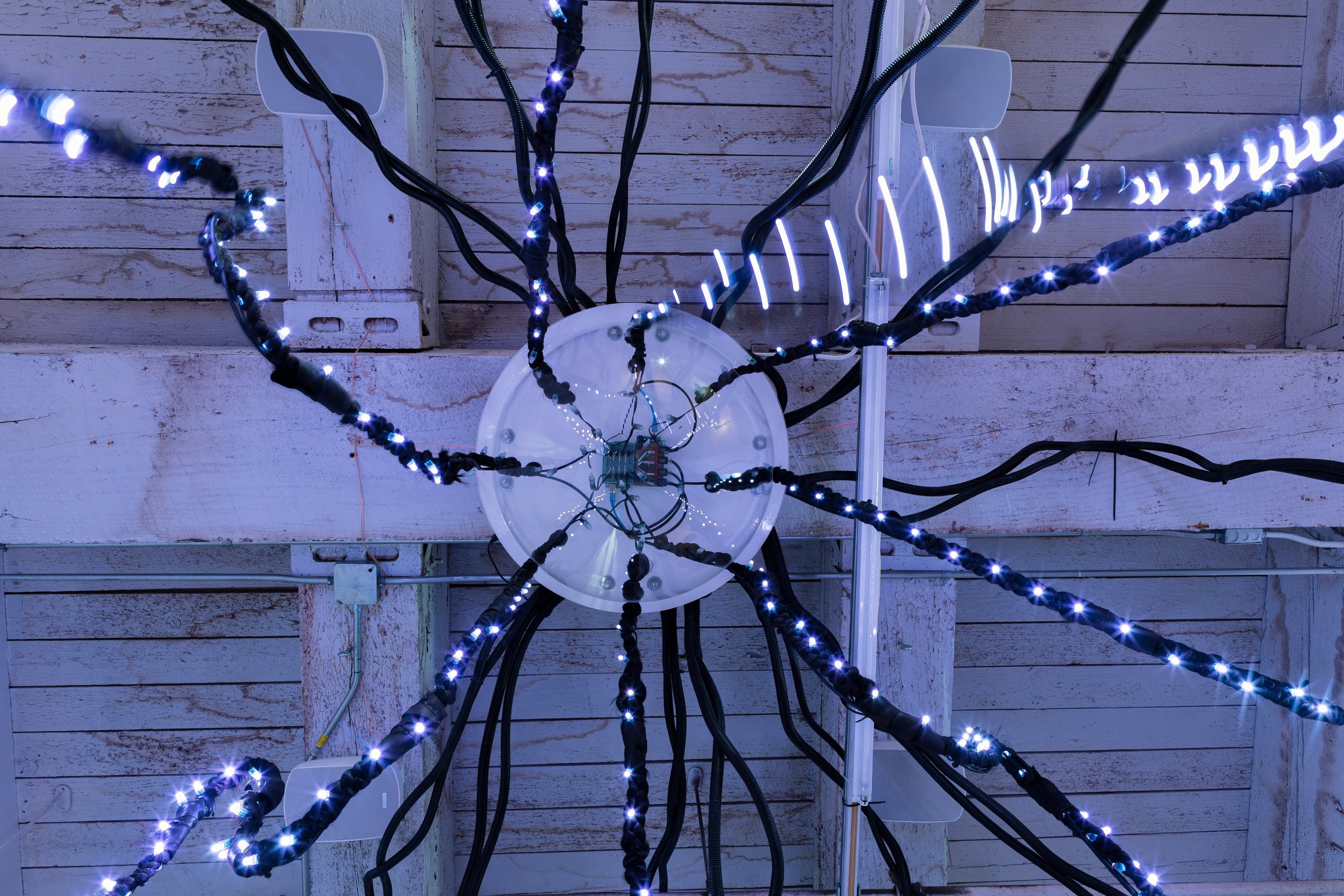This module introduces a variety of artists who explore the role of language in contemporary Indigenous art, culture, and identity.
Language revitalization plays a key role in the cultural revitalization work of several contemporary Indigenous communities. At Miami University in Oxford, Ohio (where this resource was authored), the Myaamia Center (the research and teaching arm of Miami Tribe of Oklahoma) has its roots in the language revitalization work of Daryl Baldwin. The Center’s introduction of Myaamia language and cultural education into the curriculum for Myaamia students at Miami University appear to be a key factor in Myaamia students’ academic success when, statistically, Indigenous students’ needs are underserved by universities:

Reading, Listening, and Learning
Choose one reading and one ‘listening’ from the options below to explore. Each conveys a different perspective on language, its relevance to contemporary Indigenous individuals and communities, and how digital technologies play a part in language use, learning, and preservation.

The Myaamia Center, affiliated with the Miami Tribe of Oklahoma and Miami University in Oxford, OH, uses a variety of digital media for cultural preservation and revitalization efforts, including language revitalization. In this podcast episode, Myaamia Center scholars Kara Strass, Kristina Fox, and George Ironstrack discuss how Myaamiaataweenki (Miami language) became dormant and then tell the story of the revitalization of the language from documentation over the past thirty years. They also discuss how language revitalization served as a center and starting point for the Myaamia Center’s educational and broader cultural revitalization efforts, and how digital technologies have participated in the language revitalization process.

In this podcast episode, the hosts unpack the complex story of Lakota language revitalization, and how different settler legal frameworks, academic practices, and teaching technologies have played a part. At the center of the story is tension between the centralized Lakota Language Conservancy project (founded by an Austrian anthropologist and Czech linguist) and several Lakota language speakers and teachers.

In this short write-up, researchers Caroline Running Wolf (citizen of the Apsáalooke (Crow) Nation) and Dr. Noelani Arista (Kanaka Maoli) summarize their collaborative process with a team of Indigenous linguists and technologists to develop a software tool for Indigenous language revitalization. They discuss exploring the use of AI systems as part of the tool, and some of the ways other Indigenous language projects have leveraged AI.

In this blog post, Myaamia scholar, artist, and Director of Miami Tribe Relations for the Myaamia Center Kara Strass discusses the ILDA software developed by the Myaamia Center to facilitate language preservation and teaching (including the development of an online Myaamiaataweenki dictionary). She also discusses how the software has been made available to other Indigenous communities, and the role digital tools can play in language preservation and revitalization.
Reflect After Reading
- Over your life, how have changes in digital technologies changed the ways you communicate?
- How have changes in digital technologies changed the ways you learn language (whether learning your home language(s) as a native-speaker, learning a foreign-to-you language in a school setting, learning a heritage language that is not your first language)?
- Another way to think of this question is: How have technologies changed the way you learn language in comparison to your older relatives?
- There are countless online dictionaries for languages that have not been threatened or rendered dormant by colonialism, but the Myaamia Center had to develop their own digital dictionary system (ILDA), and it has since been used by other Indigenous communities.
- Searching online, find at least one other example of a project to expand or create an alternative to some kind of digital language tool (besides a dictionary) that has heretofore excluded or decentered Indigenous languages. This could be a large-scale academic endeavor, or an individual creative project.
- The term “digital language tool” is intentionally a bit vague here! Consider all the possible ways digital systems present, produce, process, and store language: fonts/typefaces, automated translators, video captions, physical and on-screen keyboards, screen-readers, speech-to-text systems
- Which community is engaging in this project (or what community does the individual working on this project belong to)? What need(s) are they fulfilling through this project? What tool(s) are they using?
- Searching online, find at least one other example of a project to expand or create an alternative to some kind of digital language tool (besides a dictionary) that has heretofore excluded or decentered Indigenous languages. This could be a large-scale academic endeavor, or an individual creative project.
Exemplar Artists + Works
Explore these works by contemporary Indigenous artists/thinkers/makers who are engaging with concepts around language, digital systems, and Indigeneity.
As you explore, choose two works to research in greater depth which you may include as exemplars in your own lesson on language. Consider: How do these digital artworks use, center, and/or revitalize Indigenous languages? Why does each particular artwork center language – what is it using language to do?

Sadie Red Wing (enrolled member, Spirit Lake Sioux Tribe)

Elisa Harkins (enrolled member, Muscogee (Creek) Nation)

Suzanne Kite (Enrolled member, Oglala Sioux Tribe)
(video of Kite discussing this work)

Susan Blight (Anishinaabe, enrolled member Couchiching First Nation)
Casey Koyczan (Tłı̨chǫ citizen, Dene)

Scott Benesiinaabandan (Anishinaabe, a member of Obishkkokaang/Lac Seul First Nation)

Danielle Boyer (Ojibwe, enrolled citizen of the Sault Ste Marie Tribe of Chippewa Indians)
Lesson Development
Having explored the above concepts and materials, now it’s your turn to plan an arts learning experience.
- The targeted age range, materials, and art activities are yours to choose.
- You are required to meaningfully include at least two of the above artists (feel free to explore the site for more!)
- You are encouraged to develop a lesson that involves some sort of digital making, but a meaningful physical making experience rooted in ideas from these digital artists is also a viable approach!
- Please use this lesson plan template to structure your planning
Consider: How might students design digital mappings or places that resist, subvert, or operate outside of settler-colonial understandings of land and place?
- How does the positionality (settler or Indigenous) of the student artist impact their approach to this problem?
- How does the positionality of you as teacher (settler or Indigenous) impact your approach to teaching this concept?
This page last edited on April 24, 2024.